Video tour of the largest art collection of works about the Holodomor by Morgan Williams
On June 8, 2024, American Morgan Williams, the owner of the largest collection of artworks about the Holodomor, passed away. In a video tour, Mr. Williams shares the story of how this collection was formed and where it all began and highlights some of the interesting works in this collection. We provide the English transcript of this video for your reference.
My name is Morgan Williams. I serve as the President and Chief Executive Officer of the U.S. Ukraine Business Council. The Business Council is sponsoring this exhibition about the Holodomor through the eyes of Ukrainian artists.
I’m also the founder collector and trustee of the Holodomor collection. Around 1995, I contacted James Mace, who was a famous Holodomor researcher and was working in Kiev. I told him I noticed that there were very few visuals about the Holodomor. Very few photographs, no paintings, no music, no bandura concerts. It was interesting that there was almost nothing visually or musically about the Holodomor. He explained to me about the massive cover-up.
He said it was one of the most massive cover-ups in history. The Soviet Union did everything to keep it quiet and to keep it under the cover. He said, Morgan, you don’t understand. “If you painted about it, or if you sang a song about it, if you were a bandurist, if you did poetry, you probably wouldn’t be around very long.” So he said the massive cover-up lasted for many years. So I said, it’s very interesting to see if we could find any artwork, anything visually.

Morgan Williams
So it’s always important when there’s a great disaster that it’s covered by the news media and it’s covered by the artistic community so you can see visually the impact of what happened and not just read it in books. So James Mace said, well, maybe some of the artists in 1989 maybe started when things opened up. So I started searching to see if there was any artwork by Ukrainian artists about the Holodomor.
We started checking on some poster artists because poster artists were the most likely to do something. But the poster industry had totally collapsed under the Soviet Union in 1989. And the poster artists then didn’t have any work, but they started doing posters on their own and having their own exhibitions. Some of them did works about the Holodomor, about Chernobyl, about the destruction of culture.
So, I contacted poster artists. I found about eight or ten Holodomor posters from these poster artists, which we added to the collection. So the search began and it lasted in 1995 to 2000. So, the search lasted for about five years. We networked it. We visited hundreds of studios, looking for artwork about the Holodomor.
There were not very many artists in Ukraine that would paint about this subject. Nobody would buy artwork about this subject. And the ones that did, I found when I interviewed them. Most of the ones who lost relatives, who lost family in Holodomor.
And they wanted to use their talents from their soul and their heart to express what were their feelings about the destruction, the massive destruction of people and the farms and the businesses in Ukraine. All the artists, all the artworks are original artworks and they’re all from, most all of them from artists in Ukraine. We had a great time visiting with the artists and having them tell us the stories about why they did the artwork.
There are about 75 artworks on display at the Ukraine House here. The collection has over 250 different artworks showing the Holodomor. So it was a labor to put together the only visual collection of artwork that actually showed the destruction of the Holodomor, showed what happened to people, showed what happened in Ukraine.
The artists were very cooperative and helped to find artworks. As I said, we visited several hundred studios, went down to Kharkiv, went down to Poltava, went to Odessa looking for various artwork. Whenever we found it, we talked to the artist and we purchased it to hold in the collection.
The poster propaganda art in the Soviet Union was in a very advanced industry. They had special poster schools. They trained many poster artists. They had many contests. They had many exhibitions. So some of the best poster artists in the world were the ones that did these posters. Those are the ones that I wanted to find. Many of them showed me some anti-USA posters that they had done before the breakup of the Soviet Union. So again, none of these posters were created by computers. They’re all original artwork on board or on canvas. There’s also letter cuts. There’s also pencil and paper drawings. A whole wide variety of artworks, by a wide variety of artists who again decided they wanted to do something about this. They were very unique and they were very rare. And it’s very important that the works that they’ve done. If we hadn’t saved them from their studios, many of them would have been lost, many of them would have been thrown out and there wouldn’t have been a chance. So, putting this collection together was to me a very important factor in being able for the first time to show the impact of the Holodomor by Ukrainian artists.
There’s a lot of hidden subjects, hidden meanings, but very important and critical meanings in the artwork. And I’ll be sure that the artwork is an accurate display of what these artists felt about the Holodomor and how they wanted to tell the world about what happened in Ukraine in 1932 and 33, even though it was in the 1990s. Because again, nothing could be done like this while the Soviet Union was alive and powerful and covering up what happened.
The three artworks that you see behind me are by a very well-known outstanding poster artist in Kyiv, Valerii Viter. Valerii was trained under the Soviet Union and he actually showed me some posters that he did which were anti-USA. But after the Soviet Union fell, he was a true patriot. He was very multitalented. He was a part of a folk art singing group. He could write poetry and he could do outstanding posters. One of them shows a man with his hands holding wheat. And as the wheat falls to the ground, the wheat kernels turn to skulls. Another one shows a field of candles, which is in honor of all the millions that died in the Holodomor. The other one shows a cross in a field says 1932-33, which is again in memory of the those who died in the Holodomor. Three very outstanding examples of poster art from Ukraine.
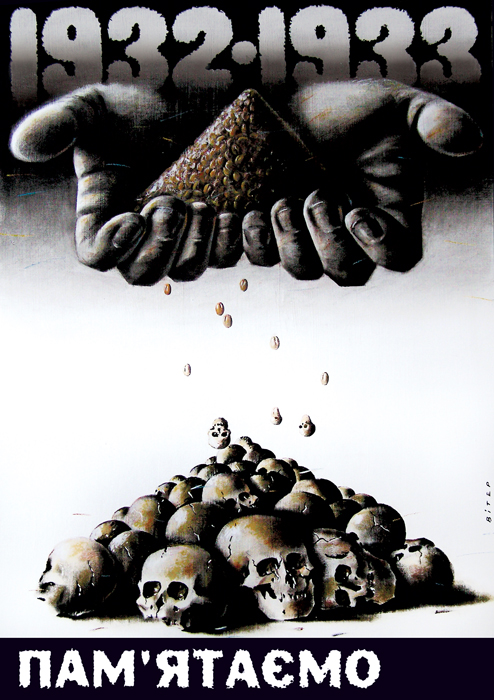
A poster by Valerii Viter
You see here, it’s very creative and very stark and very realistic. He used bones to spell out 1932. We’ll see another one where he used it to spell out 1933. When we put up the first Holodomor exhibition in Kyiv at the teacher’s house in the year 2000, some people from the labor union came by and they didn’t like it and they demanded that the head of the teacher’s house take it down. They said this didn’t happen. This is a farce. The head of the teacher’s house said no, we’re not going to take it down and she actually left it up another week because they complained. So, even in 2000, there were people who wanted to deny the Holodomor and not allow the public exhibitions of the visual concept of the Holodomor.
Here on the right, you will see the second part of the Dyptykh by Valerii Viter where he used the bones to show the Holodomor 1932 and 1933. He wanted to use some very stark realism. He wanted to tell it like it was. Some people thought this was a little too much in terms of how to depict the Holodomor, but they’ve been very well accepted and I think it’s very creative how he used the bones to make the years 1932-1933. No question that he felt this was a very honest, upfront and realistic way to depict a tragedy of what happened to millions of people.
This artwork behind me is a painting by Viktor Zaretsky. Viktor was a very famous Ukrainian for many years. He was a famous dissident. He fought against the Soviet Union. He was put up with many trials and tribulations and fought hard and formed some groups against the Soviet Union. They were after him all the time. As he became older, he decided he wanted to do something about the Holodomor and of course it was 1989 and finally you could do a painting like this. So he did this very large painting to show the trail, the row of death coming down the middle with the figure of death there and the bodies. It’s a very colorful photo. It has some gold leaf on it. It’s one of the masterpieces that’s in the collection by Viktor Zoransky. It’s the only one that he did about the Holodomor and he did this not long before he died.
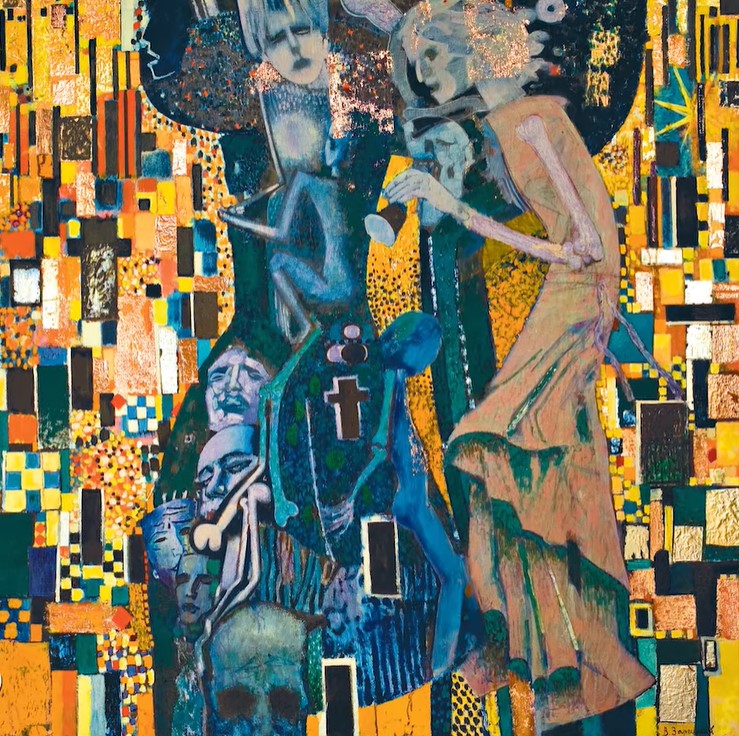
A fragment of a painting by Viktor Zaretskyi.
This painting here was a special painting in 1953 by Viktor Tsymbal. Viktor Tsymbal was one of the most famous Ukrainian artists in the United States. He did all kinds of graphics, advertising. He was very well known and very famous. The first graphics I found about the Holodomor were two postcards out of Germany by Ukrainians that were distributed underground. Then in 1953 was the first ever major Holodomor commemoration in the United States. There was a big commemoration in New York City. He did this painting for that commemoration and we have photos of the commemoration with his painting behind it. This is the only part of it. The entire painting is 10 feet tall and it’s very dramatic and very moving. So it’s one of the most important paintings. Not very long ago an original copy of this painting was found in New York and it was donated to the Holodomor Museum in Kyiv.
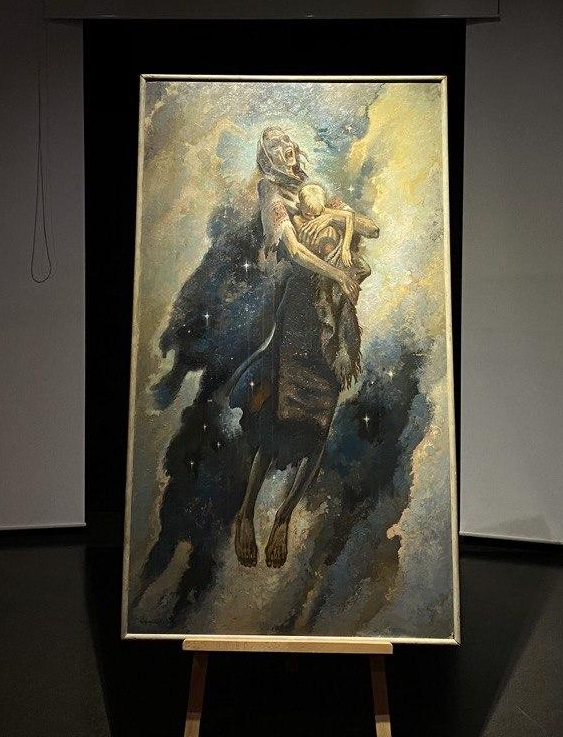
Viktor Tsymbal “1933”
The two large artworks behind me are two of the best masterpieces in the collection.
They were done by an artist in Kyiv by the name of Mykola Pavlusenko and he was very well known and when he found out that he had incurable cancer he decided he wanted to do two artworks which showed his hatred of the Soviet Union and what he thought about Lenin and Stalin. So he made these two masterpieces. They have about 50 different symbols in them so you have to look at them carefully. All of the people around Lenin and Stalin are shown as bats. The fallen Tsar’s statue is there. There’s the Holodomor depicted in wheat. They’re just full of symbols of the Soviet Union including their art style. So I visited his wife. He wanted them given to a museum but after several visits I convinced her that if you give them to a museum they probably end up in storage and never be seen again. So she decided that this was the best place for them because we told her we would put them on exhibit and they would be seen. So we’re very fortunate to have these two masterpieces as a part of the collection.

A fragment of a painting by Mykola Pavlusenko.
Here you will see two paintings by a famous female artist in the Kyiv who is a famous folk art artist. She came from a small village in the Poltava region and she’s been a professor at Art Academy for many years. Her artwork is very well sought after and is held by many collectors in many countries. When I went to see her to talk to her about her family she said that her grandfather and grandmother both died horrible deaths in the famine. So she said that she would some artwork about that. So the one here shows her grandfather yelling and screaming in horror about what’s happening and said, Lord what for? What for? What’s the reason? Why are we dying? Why are we dying by famine? And you see the grandmother laying there on the ground. It’s a very emotional painting by her about her the death of her grandmother and her grandfather.
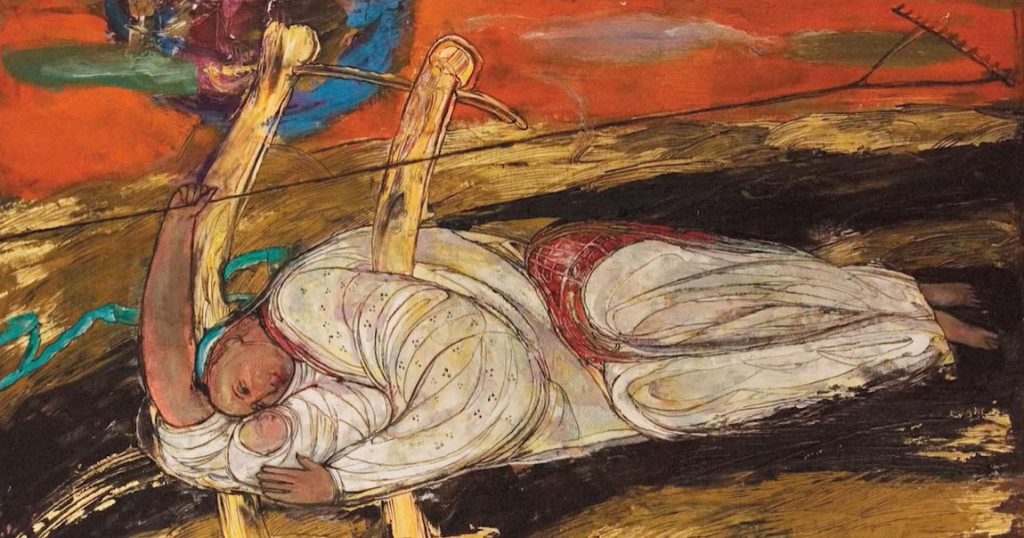
Painting by Vira Barynova-Kuleba.
The painting here shows a lady with her baby laying on the ground and she’s holding on to a barbed wire and she’s saying this is your land. You know this is your land you can’t take it away. This is not somebody else’s land. It’s not the Soviet’s land. This is Ukrainian land. So she is in a very impassioned way is trying to tell her child that this is your land.
These are two of the posters that as we’ve had them in exhibitions. Two of the ones that people like most. This one is of course crosses in a wheat field and it’s by Mykola Chervotkin and it says and no one wanted to die. So it’s very graphic about and it says 32 33 on the crosses. It’s very symbolic of what happened and it’s very expressive that no one wanted to die.
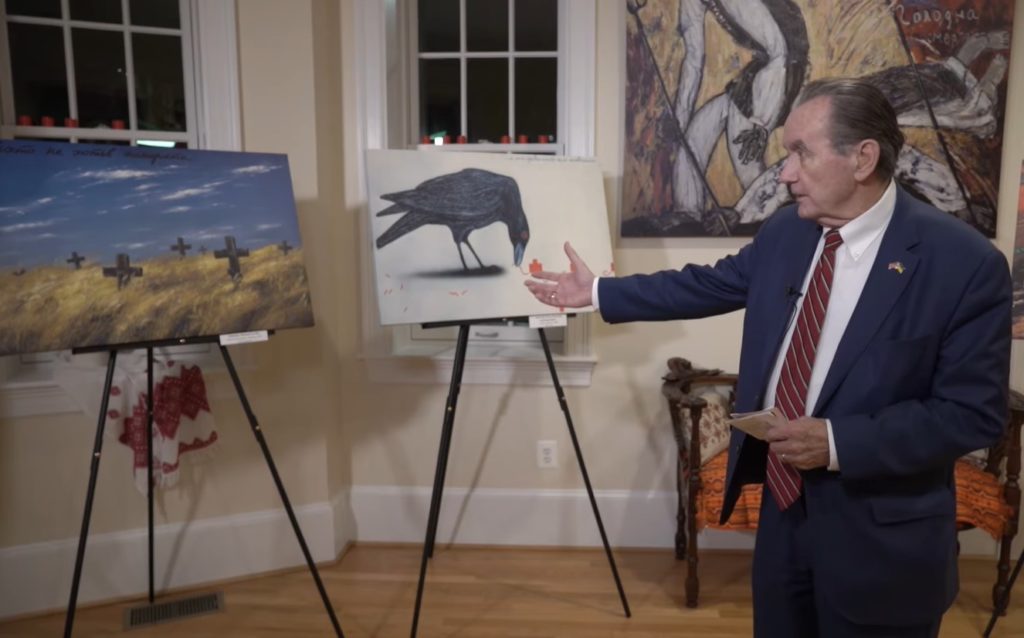
Morgan Williams near Mykola Chervotkin’s work.
This other one is a crow picking away at the embroidery of Ukraine and the author is unknown but it says and we were watching and keeping silent.
More photographs have taken of these two posters than others. When we had the first exhibition in Ukraine. When President Viktor Yushchenko came, he took out his camera, made it took pictures of the two of these.
One day a person called me and told me that they’d heard about a linocut artist up in the the Sumy Oblast who they thought they’d done something about the whole of the war. This painting here is my Mykola Bondarenko from the Sumy Oblast. He was a woodcut or linocut artist and he made his living doing linocuts. But in 1989 he said he wanted to use his talents some way to show the whole of the war. He didn’t want to just show dead bodies. So he came up with the idea of interviewing everybody who survived and he interviewed them and said how did you survive? What foods did you have to eat? What did you find in the forest? What did you find in the creeks? Well how did you prepare it in your fight to stay alive? So he did a little he found about 65 different items. He did a little kind of every one of them and they published a book called a cookbook Ukraine 32-33. This is about the tree of life showing mainly the tree of death with the lady here and all the people who died and shows the tree and the hands coming up and then the image of Ukraine. It’s a very dramatic image.
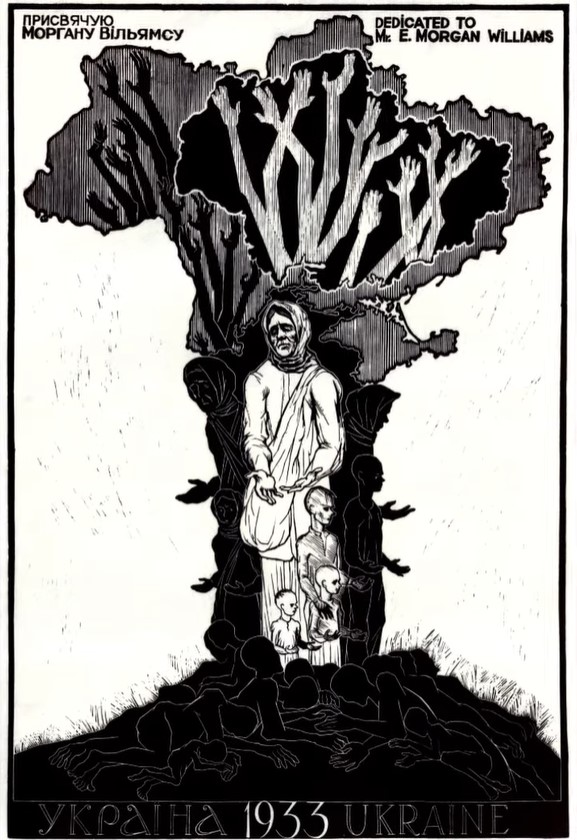
Linocut by Mykola Bondarenko, dedicated to Morgan Williams.
It’s one of them that he did as a linocut out of the Sumy Oblast. Mykola Bondarenko came up with the idea of interviewing who survived to find out what kind of food they had. What did they find to eat? How did they process it in their struggle in their fight to stay alive? He then took all these notes over several months and he did about 65 little cuts which are found in this book which is called Ukraine 1933 a cookbook.

Linocut by Mykola Bondarenko “Small animals”
And he made a window and in every window it shows the product that somebody tried to eat in order to survive and stay alive.
This was the back cover of his cookbook showing the knife with the blood on it in the bowl of empty food and then this was also in his cookbook.
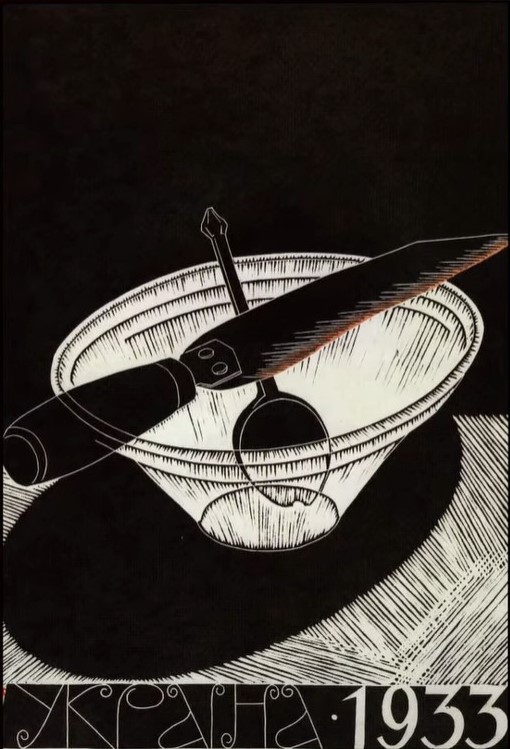
Mykola Bondarenko’s linocut “The Penultimate”.
It showed the steel rods which were used by people that worked for the Soviet Union that came to the farms and came to the houses and they would they would tear your house apart. They would stick the poles in the ground outside the house. Any place they thought maybe you were hiding bread or you were food. It was just the hooks and crooks. It was just amazing the extent to which the authorities went to to take food away from people and to keep them from finding something to eat and starving to death. It was not just the big harvest but it was also house to house, farm to farm, doing everything possible to find where people hid food and to take it from them to increase the level of the starvation.
This painting over here is actually one of my favorites. It shows bureaucrats, nameless, faithless. It shows powerful states that are out of control and it’s by a painter by the name of Maksymov and as you can see the title of it is Everything Belongs to the State. And here you show this nameless, faithless bureaucrat taking this apple from this little baby because everything belongs to the state.
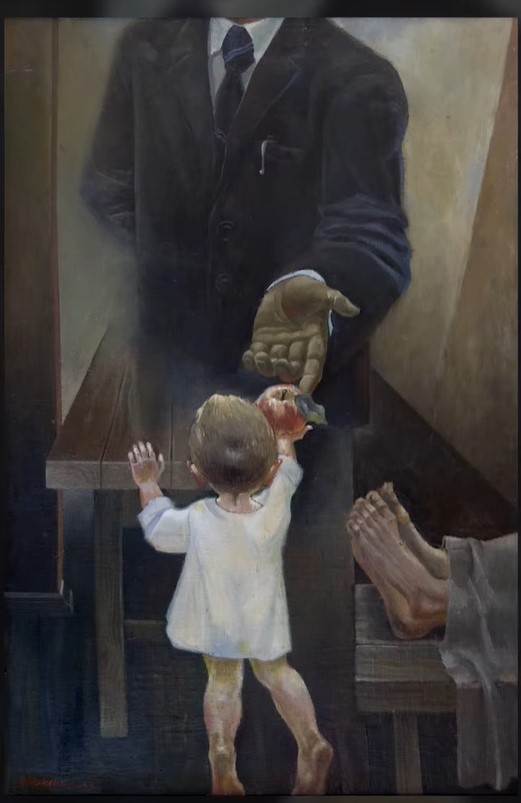 Artist V. Maksymov “Everything belongs to the state”
Artist V. Maksymov “Everything belongs to the state”
And you see the body of the dead person laying on the table and as you know they (communists) passed a law that everything belonged to the state and if you went out and picked up grain in the field after harvest, they could arrest you for stealing government property. It was just amazing that they said everything that everybody had, their houses, their food, their grain, their crops, their animals, everything belonged to the state.
The triptych that you see over here is a very amazing painting. Someone told me to check out a folk artist that lived over in Poltava. They said that he was a very strong patriot and they knew that he did paintings about Independence Day. He did an independence about his nephew dying in Afghanistan. He did paintings about Chernobyl. He did paintings about a lot of political and social issues which was very, very rare. He probably did more paintings about those issues than any other artist that I found. (This is about the artist Ivan Novobranets. – Ed.)

Morgan Williams near the triptych by Ivan Novobranets.
These are about his brother Ivan. Ivan died in the Holodomor. When he was born about six years later his parents named him Ivan. On the right of this triptych you’ll see his mother wailing, yelling into the sky and with her dead son laying on the ground. And on the left you will see the mother and father, his mother and father laying there with the dead son. And in the middle you’ll see a very nice painting of his village. And in the village there’s a graveyard and there’s a pot of flowers on the graveyard of his brother. He said this was a very emotional work for him. He was told about the Holodomor many times about his family and about the excruciating horror of the death of his brother. So this is his way through his artistic talents and his eyes to show what happened in his village to his mother and father in his village.
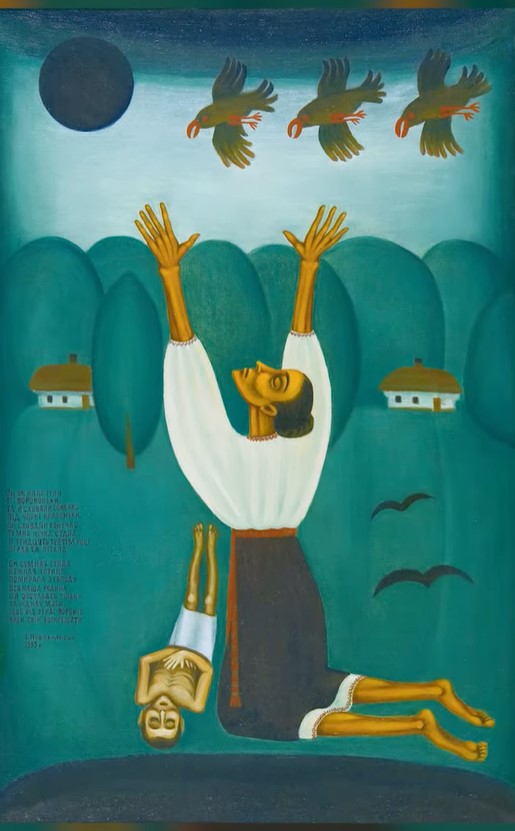
A painting by Ivan Novobranets.
So this is a very interesting graphic, very interesting poster. It was done by two poster artists in Nikopol. We found out about it, drove down to find them. It shows a large red rat eating underneath the ground, eating the bread, eating under the field of wheat. And it says the wounds will heal but souls will never heal. It’s a very, I think, very creative, very expressive. Shows the red rat of the Soviet Union, the bureaucrats who used every means possible to destroy people’s food and make their lives miserable and cause their death.
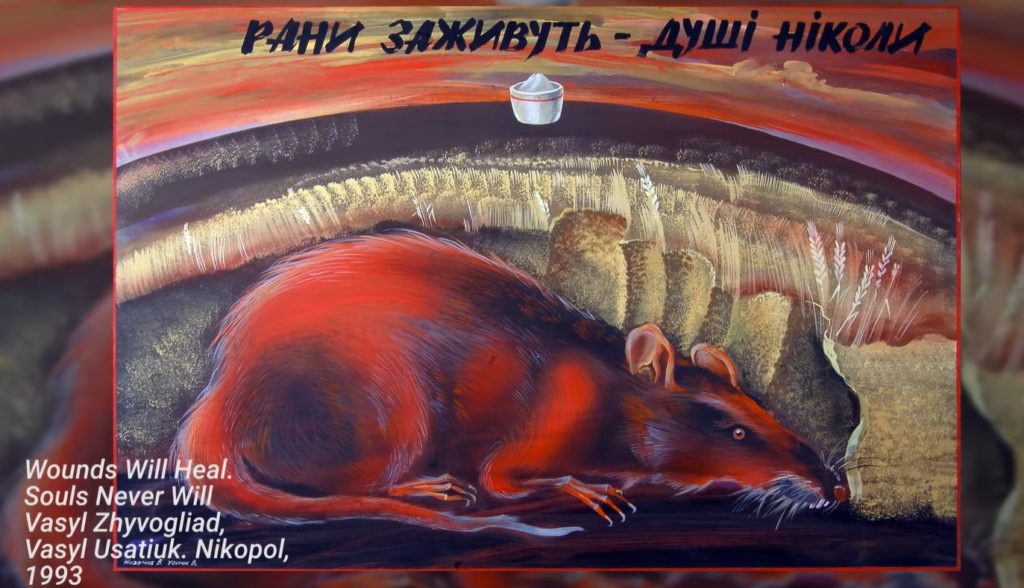 The work by Vasyl Zhyvohliad and Vasyl Usatiuk.
The work by Vasyl Zhyvohliad and Vasyl Usatiuk.
These are very two historic examples of very early Holodomor depictions visually.
You know, the Holodomor was covered up and there was World War II and there were no opportunities for commemorations, no opportunities to honor those who died. These are two enlarged postcards which were put out by the Ukrainian Youth Union underground in Germany and they were very controversial and of course they could have gotten in trouble because here you have Stalin and showing the grain that he stole and the dead bodies and then here you have the symbol of death that swept across Ukraine. So these were very brave Ukrainians who started the underground movement to start depicting the Holodomor visually in these postcards.
These are the only two I found and again as far as I know they are the earliest examples of Holodomor being shown by Ukrainians. And the next ones came out in the United States in 1953 and some in Canada where the first ever real commemoration of the Holodomor victims took place on the 20th Anniversary of the Holodomor.
Thank you very much for watching this video about the horrible events and the destruction, and the death of millions of people that took place in Ukraine in 1932-33. It was all orchestrated by the authorities of the Soviet Union who ran a state that was out of control. They said that all property belonged to the state, and they wanted all farms to go to co-host, so they passed the law, and all the property belongs to the state. The farmers and rural people in Ukraine resisted so they undertook the massive famine which killed millions of people. It was covered up dramatically in a huge way for years, and years, and years. And very few photographs, almost no artwork, and other things by artists. There were not poems and songs were not allowed. So it’s very important to see such a tragedy against people to Ukraine by visually. In the early way we found to do that was to find artists after 1989 who chose because of their passion because of their loss relatives and family in the Holodomor to do some Holodomor artwork. There were few and far between. But from 1995 to 2000 we searched hundreds of Studios. We networked with all kinds of artists to find artwork that people did. Most of us in the back of their Studios. Nobody bought Holodomor artwork so we put together the only large collection of Holodomor artwork to the eyes of Ukrainian artists that exists. We have about 85 examples here. There are many more. So we appreciate the opportunity to show that work of very courageous Ukrainian artists who had the courage and who had the fortitude to put into visually what they knew actually happened in Ukraine. Thank you very much!
A Source of the video tour – U.S.-Ukraine Business Council (USUBC)
